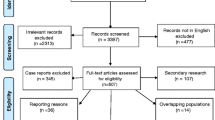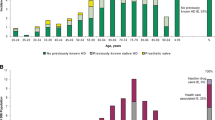Abstract
US and European guidelines recommend a daily divided gentamicin dose (3 mg/kg in two or three equally divided doses) for the treatment of infective endocarditis caused by staphylococci or enterococci, but once-daily dosing (3 mg/kg/day) is recommended for streptococcal endocarditis. However, studies have recommended the use of higher doses of gentamicin (4 or ≥5 mg/kg/day) administered once-daily. A survey was conducted in France by mailing a questionnaire to the 595 members of the French Infectious Disease Society regarding their gentamicin prescription patterns in infective endocarditis, focusing on the dosing regimen. The survey was answered by 137 physicians (23%). The proportions of physicians following guideline-based regimens were similar for each organism (30.9%, 38.8%, and 39.4% for staphylococci, enterococci, and streptococci, respectively [p = 0.26]). In contrast, the proportions of physicians following literature-based regimens were significantly different for each organism (59.6%, 42.5%, and 27.7% for staphylococci, enterococci, and streptococci, respectively [p < 0.001]). The number of years practicing and the type of practice (university vs. non-university hospital) did not influence the gentamicin dose or regimen. Although adherence to published guidelines for gentamicin administration in patients with infective endocarditis was poor, a large proportion of physicians who did not follow those guidelines used literature-based regimens.


Similar content being viewed by others
References
Hoen B, Alla F, Selton-Suty C, Béguinot I, Bouvet A, Briançon S, Casalta JP, Danchin N, Delahaye F, Etienne J, Le Moing V, Leport C, Mainardi JL, Ruimy R, Vandenesch F; Association pour l’Etude et la Prévention de l’Endocardite Infectieuse (AEPEI) Study Group (2002) Changing profile of infective endocarditis: results of a 1-year survey in France. JAMA 288(1):75–81
Cabell CH, Jollis JG, Peterson GE, Corey GR, Anderson DJ, Sexton DJ, Woods CW, Reller LB, Ryan T, Fowler VG Jr (2002) Changing patient characteristics and the effect on mortality in endocarditis. Arch Intern Med 162(1):90–94
Murdoch DR, Corey GR, Hoen B, Miró JM, Fowler VG Jr, Bayer AS, Karchmer AW, Olaison L, Pappas PA, Moreillon P, Chambers ST, Chu VH, Falcó V, Holland DJ, Jones P, Klein JL, Raymond NJ, Read KM, Tripodi MF, Utili R, Wang A, Woods CW, Cabell CH; International Collaboration on Endocarditis-Prospective Cohort Study (ICE-PCS) Investigators (2009) Clinical presentation, etiology, and outcome of infective endocarditis in the 21st century: the International Collaboration on Endocarditis-Prospective Cohort Study. Arch Intern Med 169(5):463–473
Habib G, Hoen B, Tornos P, Thuny F, Prendergast B, Vilacosta I, Moreillon P, de Jesus Antunes M, Thilen U, Lekakis J, Lengyel M, Müller L, Naber CK, Nihoyannopoulos P, Moritz A, Zamorano JL, Vahanian A, Auricchio A, Bax J, Ceconi C, Dean V, Filippatos G, Funck-Brentano C, Hobbs R, Kearney P, McDonagh T, McGregor K, Popescu BA, Reiner Z, Sechtem U, Sirnes PA, Tendera M, Vardas P, Widimsky P (2009) Guidelines on the prevention, diagnosis, and treatment of infective endocarditis (new version 2009): the task force on the prevention, diagnosis, and treatment of infective Endocarditis of the European Society of Cardiology (ESC). Endorsed by the European Society of Clinical Microbiology and Infectious Diseases (ESCMID) and the International Society of Chemotherapy (ISC) for Infection and Cancer. Eur Heart J 30(19):2369–2413
Baddour LM, Wilson WR, Bayer AS, Fowler VG Jr, Bolger AF, Levison ME, Ferrieri P, Gerber MA, Tani LY, Gewitz MH, Tong DC, Steckelberg JM, Baltimore RS, Shulman ST, Burns JC, Falace DA, Newburger JW, Pallasch TJ, Takahashi M, Taubert KA, Committee on Rheumatic Fever, Endocarditis, and Kawasaki Disease, Council on Cardiovascular Disease in the Young, Councils on Clinical Cardiology, Stroke, and Cardiovascular Surgery and Anesthesia, American Heart Association; Infectious Diseases Society of America (2005) Infective endocarditis: diagnosis, antimicrobial therapy, and management of complications: a statement for healthcare professionals from the Committee on Rheumatic Fever, Endocarditis, and Kawasaki Disease, Council on Cardiovascular Disease in the Young, and the Councils on Clinical Cardiology, Stroke, and Cardiovascular Surgery and Anesthesia, American Heart Association: endorsed by the Infectious Diseases Society of America. Circulation 111(23):e394–e434
Francioli P, Ruch W, Stamboulian D (1995) Treatment of streptococcal endocarditis with a single daily dose of ceftriaxone and netilmicin for 14 days: a prospective multicenter study. Clin Infect Dis 21(6):1406–1410
Sexton DJ, Tenenbaum MJ, Wilson WR, Steckelberg JM, Tice AD, Gilbert D, Dismukes W, Drew RH, Durack DT (1998) Ceftriaxone once daily for four weeks compared with ceftriaxone plus gentamicin once daily for two weeks for treatment of endocarditis due to penicillin-susceptible streptococci. Endocarditis Treatment Consortium Group. Clin Infect Dis 27(6):1470–1474
Tsuji BT, Rybak MJ (2005) Short-course gentamicin in combination with daptomycin or vancomycin against Staphylococcus aureus in an in vitro pharmacodynamic model with simulated endocardial vegetations. Antimicrob Agents Chemother 49(7):2735–2745
Gavaldà J, Cardona PJ, Almirante B, Capdevila JA, Laguarda M, Pou L, Crespo E, Pigrau C, Pahissa A (1996) Treatment of experimental endocarditis due to Enterococcus faecalis using once-daily dosing regimen of gentamicin plus simulated profiles of ampicillin in human serum. Antimicrob Agents Chemother 40(1):173–178
Nicolau DP, Freeman CD, Belliveau PP, Nightingale CH, Ross JW, Quintiliani R (1995) Experience with a once-daily aminoglycoside program administered to 2,184 adult patients. Antimicrob Agents Chemother 39(3):650–655
Rogers MS, Cullen MM, Boxall EM, Chadwick PR (2005) Improved compliance with a gentamicin prescribing policy after introduction of a monitoring form. J Antimicrob Chemother 56(3):566–568
Leong CL, Buising K, Richards M, Robertson M, Street A (2006) Providing guidelines and education is not enough: an audit of gentamicin use at The Royal Melbourne Hospital. Intern Med J 36(1):37–42
Tattevin P, Chapplain JM, Lesprit P, Billy C, Roblot F, Alfandari S, Bernard L, Rouveix E, Bouvet E (2006) Tuberculosis treatment duration in France: from guidelines to daily practice. Eur J Intern Med 17(6):427–429
Acknowledgments
Medical writing assistance was provided by Lucy Whitehouse of inScience Communications, a Wolters Kluwer business, and was funded by Astellas Pharma Inc.
Competing interests
The authors declare that they have no conflict of interest.
Ethical approval
Not required.
Author information
Authors and Affiliations
Corresponding author
Additional information
All of the authors contributed equally to the article.
Rights and permissions
About this article
Cite this article
Béraud, G., Le Moal, G., Elsendoorn, A. et al. A survey on the use of gentamicin in infective endocarditis. Eur J Clin Microbiol Infect Dis 31, 1413–1418 (2012). https://doi.org/10.1007/s10096-011-1458-9
Received:
Accepted:
Published:
Issue Date:
DOI: https://doi.org/10.1007/s10096-011-1458-9




